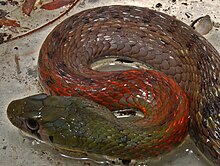Rhabdophis
| Rhabdophis | |
|---|---|

| |
| Rhabdophis subminiatus | |
| Scientific classification | |
| Domain: | Eukaryota |
| Kingdom: | Animalia |
| Phylum: | Chordata |
| Class: | Reptilia |
| Order: | Squamata |
| Suborder: | Serpentes |
| Family: | Colubridae |
| Subfamily: | Natricinae |
| Genus: | Rhabdophis Fitzinger, 1843 |
| Species | |
|
27, see text. | |
Rhabdophis is a genus of snakes in the subfamily Natricinae of the family Colubridae. Species in the genus Rhabdophis are generally called keelback snakes, and are found primarily in Southeast Asia.
Toxicity
While the term "poisonous snake" is often incorrectly used for a wide variety of venomous snakes, some species of Rhabdophis are in fact poisonous. Keelback snakes have glands that secrete poison they ingest from eating poisonous toads. While both venom and poison are toxins, a venom requires direct delivery, for instance subcutaneously through a snake bite, but can be ingested without harm. A poison can also be absorbed indirectly, e.g., by touch or through the digestive system.[1] At least some members of the genus, such as Rhabdophis subminiatus, are strongly venomous and are thus potentially dangerous to humans.[2][3]
Species
These species are recognized as being valid:[4]
- Rhabdophis adleri Zhao, 1997
- Rhabdophis akrios Doria et al., 2013
- Rhabdophis angeli (Bourret, 1934)
- Rhabdophis auriculatus (Günther, 1858)
- Rhabdophis barbouri (Taylor, 1922) – Barbour's water snake[5]
- Rhabdophis callichroma (Bourret, 1934)
- Rhabdophis callistus (Günther, 1873)
- Rhabdophis ceylonensis (Günther, 1858)
- Rhabdophis chiwen Chen, Ding, Chen, & Piao, 2020 – Chiwen keelback
- Rhabdophis chrysargoides (Günther, 1858)
- Rhabdophis chrysargos (Schlegel, 1837) – specklebelly keelback
- Rhabdophis conspicillatus (Günther, 1872)
- Rhabdophis flaviceps (Duméril, Bibron & Duméril, 1854)
- Rhabdophis guangdongensis Zhu et al., 2014
- Rhabdophis himalayanus (Günther, 1864) – orange-collared keelback
- Rhabdophis leonardi (Wall, 1923) – Burmese keelback
- Rhabdophis lineatus (W. Peters, 1861) – zigzag-lined water snake
- Rhabdophis murudensis (M.A. Smith, 1925)
- Rhabdophis nigrocinctus (Blyth, 1856) – black-striped keelback
- Rhabdophis nuchalis (Boulenger, 1891)
- Rhabdophis pentasupralabialis Jiang & Zhao, 1983
- Rhabdophis plumbicolor (Cantor, 1839)
- Rhabdophis rhodomelas (Boie, 1827)
- Rhabdophis spilogaster (F. Boie, 1827) – northern water snake
- Rhabdophis subminiatus (Schlegel, 1837) – red-necked keelback
- Rhabdophis swinhonis (Günther, 1868) – Swinhoe's grass snake[5]
- Rhabdophis tigrinus (H. Boie, 1826) – tiger grooved-neck keelback, tiger keelback, Japanese grass snake, yamakagashi
Nota bene: A binomial authority in parentheses indicates that the species was originally described in a genus other than Rhabdophis.
References
- ^ Oldfield, Molly; Mitchinson, John (10 September 2010). "QI: Quite Interesting facts about deadly poisons". The Telegraph.
- ^ Zotz, R. B.; Mebs, D.; Hirche, H.; Paar, D. (1 January 1991). "Hemostatic changes due to the venom gland extract of the red-necked keelback snake (Rhabdophis subminiatus)". Toxicon. 29 (12): 1501–1508. doi:10.1016/0041-0101(91)90006-D. PMID 1801326.
- ^ Ferlan, I.; Ferlan, A.; King, T.; Russell, F. E. (1 January 1983). "Preliminary studies on the venom of the colubrid snake Rhabdophis subminatus (red-necked keelback)". Toxicon. 21 (4): 570–574. doi:10.1016/0041-0101(83)90137-X. PMID 6623495.
- ^ Genus Rhabdophis at The Reptile Database. www.reptile-database.org.
- ^ a b Beolens, Bo; Watkins, Michael; Grayson, Michael (2011). The Eponym Dictionary of Reptiles. Baltimore: Johns Hopkins University Press. xiii + 296 pp. ISBN 978-1-4214-0135-5. (Rhabdophis barbouri, p. 16; R. swinhonis, p. 258).
External links
Further reading
- Fitzinger L (1843). Systema Reptilium, Fasciculus Primus, Amblyglossae. Vienna: Braumüller & Seidel. 106 pp. + indices. (Rhabdophis, new genus, p. 27). (in Latin).
